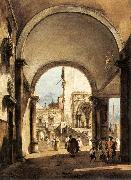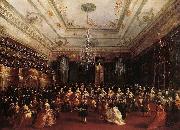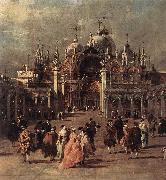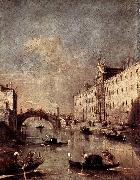All GUARDI, Francesco's oil paintings


|
|
|
| ID |
Image |
Oil Pantings, Sorted from A to Z |
Other Information |
| 7189 |
 |
An Architectural Caprice |
before 1777
Oil on canvas, 54 x 36 cm
National Gallery, London |
| 63057 |
 |
Audience Granted by the Doge |
1766-70 Oil on canvas, 66 x 100 cm Musee du Louvre, Paris The painting depicts the audience granted by the Doge to the ambassadors in the Sala del Collegio of the Doge's Palace in Venice. Artist: GUARDI, Francesco Painting Title: Audience Granted by the Doge , 1751-1800 Painting Style: Italian , , landscape |
| 7167 |
 |
Audience Granted by the Doge dfh |
1766-70
Oil on canvas, 66 x 100 cm
Mus??e du Louvre, Paris |
| 7152 |
 |
Campo Santi Giovanni e Paolo fh |
1762-63
Oil on canvas, 72 x 120 cm
Mus??e du Louvre, Paris |
| 7181 |
 |
Capriccio with Venetian Motifs sg |
1760s
Oil on canvas, 33 x 51 cm
Museo di Castelvecchio, Verona |
| 7172 |
 |
Carnival Thursday on the Piazzetta dgs |
1766-70
Oil on canvas, 67 x 100 cm
Mus??e du Louvre, Paris |
| 7188 |
 |
Doge Alvise IV Mocenigo Appears to the People in St Mark s Basilica in 1763 |
1775-77
Oil on canvas, 67 x 100 cm
Mus??es Royaux des Beaux-Arts, Brussels |
| 44408 |
 |
Doge Alvise IV Mocenigo Appears to the People in St Mark's Basilica in 1763 |
1775-77
Oil on canvas,
67 x 100 cm |
| 7205 |
 |
Fire in the Oil Depot at San Marcuola dg |
1789
Oil on canvas, 42 x 62 cm
Alte Pinakothek, Munich |
| 7207 |
 |
Fire in the San Marcuola Oil Depot sdg |
1789
Oil on canvas
Gallerie dell'Accademia, Venice |
| 63060 |
 |
Gondola |
25 x 38 cm Museo Poldi Pezzoli, Milan The lonely gondola is seen in the lagoon at the Fondamente Nuove, in front of the islands of San Cristoforo and San Michele. Artist: GUARDI, Francesco Painting Title: Gondola , 1751-1800 Painting Style: Italian , , landscape |
| 7185 |
 |
Gondola in the Lagoon dfhg |
1765-70
Oil on canvas, 25 x 38 cm
Museo Poldi Pezzoli, Milan |
| 7138 |
 |
Il Ridotto (The Foyer) dgh |
1755
Oil on canvas
Museo del Settecento Veneziano, Ca' Rezzonico, Venice |
| 44414 |
 |
Ladies Concert at the Philharmonic Hall |
1782
Oil on canvas,
68 x 91 cm |
| 63059 |
 |
Landscape |
120 x 152 cm The Hermitage, St. Petersburg One of the rare compositions of the artist not containing archtectural elements. Artist: GUARDI, Francesco Painting Title: Landscape , 1751-1800 Painting Style: Italian , , landscape |
| 7194 |
 |
Landscape sdg |
c. 1780
OIl on canvas, 120 x 152 cm
The Hermitage, St. Petersburg
|
| 7186 |
 |
Landscape with a Fisherman s Tent |
1770-75
Oil on canvas, 49 x 77 cm
Fondazione Cagnola, Villa Gazzada, Gazzada |
| 44407 |
 |
Landscape with a Fisherman-s Tent |
1770-75
Oil on canvas,
49 x 77 cm |
| 7141 |
 |
Nighttime Procession in Piazza San Marco fdh |
1758
Oil on canvas, 48 x 85 cm
Ashmolean Museum, Oxford |
| 7198 |
 |
Outward Voyage of the Bucintoro to San Nicol del Lido dfg |
1785-88
Oil on canvas, 50 x 80 cm
Private collection |
| 85143 |
 |
Pharaohs Daughter after Palma Il |
oil on Canvas
cyf |
| 7191 |
 |
Piazza di San Marco (detail) dh |
1777
Oil on canvas
Gulbenkian Foundation, Lisbon |
| 7190 |
 |
Piazza di San Marco dfh |
1777
Oil on canvas, 61 x 91 cm
Gulbenkian Foundation, Lisbon |
| 7182 |
 |
Piazza San Marco sdgh |
1760s
Oil on canvas, 62 x 96 cm
Accademia Carrara, Bergamo |
| 7195 |
 |
Pope Pius VI Blessing the People on Campo Santi Giovanni e Paolo sdg |
1782
Oil on canvas, 63,5 x 78,5 cm
Ashmolean Museum, Oxford |
| 44409 |
 |
Rio dei Mendicanti |
1780
Oil on canvas,
19,5 x 15 cm |
| 7139 |
 |
San Cristoforo, San Michele and Murano, Seen from the Fondamenta Nuove sh |
1755-60
Oil on canvas, 60,5 x 91 cm
Kunsthaus, Zurich |
| 7170 |
 |
The Coronation of the Doge dfg |
1766-70
Oil on canvas, 66 x 101 cm
Mus??e du Louvre, Paris |
| 7168 |
 |
The Doge at the Basilica of La Salute gd |
1766-70
Oil on canvas, 68 x 100 cm
Mus??e du Louvre, Paris |
| 63058 |
 |
The Doge on the Bucentaur at San Niccol del Lido |
1766-70 Oil on canvas, 67 x 100 cm Musee du Louvre, Paris This painting belongs to a series of twelve canvases, almost all in the Louvre, which recount the various episodes in the election of Doge Alvise Mocenigo of Venice in 1763. In reporting this event Guardi was inspired by engravings after the other master of the Venetian veduta (view), Antonio Canaletto. An observant and picturesque record of the traditional Venetian festival, which was part official ceremony and part popular rejoicing, this series attests to the pictorial verve of Guardi and to his sensitivity to the most fleeting atmospheric effects, worthy of the Impressionists over a century later. Artist: GUARDI, Francesco Painting Title: The Doge on the Bucentaur at San Niccol?del Lido , 1751-1800 Painting Style: Italian , , landscape |
| 7169 |
 |
The Doge on the Bucentaur at San Niccol del Lido dfh |
1766-70
Oil on canvas, 67 x 100 cm
Musee du Louvre, Paris |
| 7184 |
 |
The Doge on the Bucintoro near the Riva di San Elena (detail) |
1766-70
Oil on canvas, 66 x 100 cm (whole painting)
Mus??e du Louvre, Paris |
| 7183 |
 |
The Doge on the Bucintoro near the Riva di Sant Elena |
1766-70
Oil on canvas, 66 x 100 cm
Mus??e du Louvre, Paris |
| 44406 |
 |
The Doge on the Bucintoro near the Riva di Sant-Elena |
Oil on canvas,
66 x 100 cm |
| 7187 |
 |
The Feast of the Ascension fdh |
c. 1775
Oil on canvas, 48 x 78 cm
Gulbenkian Foundation, Lisbon |
| 7149 |
 |
The Giudecca Canal with the Zattere dgh |
c. 1759
Oil on canvas, 72 x 120 cm
Private collection |
| 7161 |
 |
The Grand Canal at the Fish Market (Pescheria) dg |
c. 1765
Oil on canvas, 56 x 75 cm
Pinacoteca di Brera, Milan |
| 7197 |
 |
The Grand Canal with San Simeone Piccolo and Santa Lucia sdg |
1780s
Oil on canvas, 48 x 78 cm
Thyssen-Bornemisza Collection, Madrid |
| 7196 |
 |
The Grand Canal with Santa Lucia and the Scalzi dfh |
1780s
Oil on canvas, 48 x 78 cm
Thyssen-Bornemisza Collection, Madrid |
| 7159 |
 |
The Grand Canal, Looking toward the Rialto Bridge sg |
c. 1765
Oil on canvas, 56 x 75 cm
Pinacoteca di Brera, Milan |
| 7150 |
 |
The Lagoon from the Fondamenta Nuove serg |
c. 1759
Oil on canvas, 72 x 120 cm
Private collection |
| 7164 |
 |
The Lagoon Looking toward Murano from the Fondamenta Nuove sdg |
1765-70
Oil on canvas, 31,7 x 52,7 cm
Fitzwilliam Museum, Cambridge |
| 7144 |
 |
The Lagoon with Boats, Gondolas, and Rafts kug |
c. 1758
Oil on canvas, 33 x 54 cm
Private collection |
| 7156 |
 |
The Molo and the Riva degli Schiavoni from the Bacino di San Marco dfg |
1760-65
Oil on canvas, 122 x 152,5 cm
Metropolitan Museum of Art, New York |
| 7209 |
 |
The Molo and the Riva degli Schiavoni from the Bacino di San Marco sdg |
c. 1760
Drawing
Private collection |
| 7157 |
 |
The Piazza San Marco towards the Basilica dfh |
1760-65
Oil on canvas, 72,5 x 119 cm
National Gallery, London |
| 63055 |
 |
The Piazzetta |
1758 Oil on canvas, 49 x 83,5 cm Museo Civico, Treviso This painting is one of the earliest views of Venice painted by Francesco Guardi. Artist: GUARDI, Francesco Painting Title: The Piazzetta, Looking toward San Giorgio Maggiore , 1751-1800 Painting Style: Italian , , landscape |
| 7143 |
 |
The Piazzetta, Looking toward San Giorgio Maggiore dh |
c. 1758
Oil on canvas, 49 x 83,5 cm
Museo Civico, Treviso |
| 7154 |
 |
The Rialto Bridge with the Palazzo dei Camerlenghi dg |
c. 1763
Oil on canvas, 60 x 91 cm
Private collection |
| 7162 |
 |
The Three-Arched Bridge at Cannaregio sdg |
1765-70
Oil on canvas
National Gallery of Art, Washington |
| 7165 |
 |
The Torre del Orologio |
1765-70
Oil on canvas, 62,5 x 89,4 cm
Akademie der bildenden K??nste, Vienna |
| 7210 |
 |
The Torre del Orologio sdg |
1765-70
Drawing
Mus??e du Petit Palais, Paris |
| 63056 |
 |
The Torre del'Orologio |
1765-70 Oil on canvas, 62,5 x 89,4 cm Akademie der bildenden K?nste, Vienna Ever since the early sixteenth century the view of Piazza San Marco has been partly determined by the Torre dell'Orologio, the construction of which was largely completed in 1506. Francesco Guardi represented the building here with the two storeys added to the wings in 1755. To the left of this is part of the Procuratie Vecchie, which at that time accommodated the procurators of San Marco, the most important representative magistracy after the Doge; on the right is the Basilica itself. It is striking that the square does not display the geometrical patterns of the paving which was laid in about 1723. Guardi recorded the view from a vantage point beyond the Campanile, though he adapted the result of his observations somewhat for the sake of the composition. By placing the walls of the Procuratie and the Torre parallel to the picture plane, the angle between these structures and the fa?ade of San Marco appear greater than in reality. This also has the effect of making the square much more spacious. There are also several details which do not entirely correspond with the actual situation, such as the three flagstaffs, which have been depicted lower and thinner than in actuality. A drawing by Guardi has been preserved that is virtually identical in terms of detail to the painting. Despite the prominent place of the Torre dell'Orologio it was seldom chosen as an independent motif by the Venetian vedutisti. Carlevaris and Canaletto did include it in paintings, but only as an incidental feature, and furthermore from a different angle. Francesco Guardi painted this theme at least eight times, always from virtually the same vantage point. Each time he gave a slightly different impression of the space by varying the relationships, the light and the positioning of the figures. In this painting the foreground is almost empty and the depth is only accentuated by the strikingly foreshortened fa?ade of San Marco and the lines of the three flagstaffs running parallel to it, and by the tents fluttering fitfully in the wind. In this simple composition Guardi emphasized the play of light and colour on the walls and the pavement. Artist: GUARDI, Francesco Painting Title: The Torre del'Orologio , 1751-1800 Painting Style: Italian , , landscape |
| 44413 |
 |
The Torre del-Orologio |
1765-70
Oil on canvas,
62,5 x 89,4 cm |
| 7193 |
 |
View of Piazzetta San Marco towards the San Giorgio Maggiore sdg |
1770s
Oil on canvas
Galleria Franchetti, Ca' d'Oro, Venice |
|
|
| GUARDI, Francesco
|
| Italian Rococo Era Painter, 1712-ca.1793
The records of his parish in Venice show that Francesco Guardi was baptized on Oct. 5, 1712. His father, Domenico, who died when Francesco was 4, had a workshop. Francesco and his elder brother, Gian Antonio, worked in a small studio, carrying out such orders as they could get for almost anything the client wanted:mythological pictures, genre, flower pieces, battle scenes, altarpieces, and even, on rare occasions, frescoes. They did not hesitate to copy compositions by other artists, but what they borrowed they always transformed into something more capricious, less stable, more fragmentary in the refraction of light. Francesco did not emerge as an independent personality until 1760, when his brother died. Then, 48 years old, he married, established his own studio, and devoted himself chiefly to painting views of Venice. For the most part he worked in obscurity, ignored by his contemporaries. He was not even admitted to the Venetian Academy until he was 72 years old. Guardi and Canaletto have always been compared to one another because the buildings they chose to paint were often the same. But the way each artist painted them is very different. Canaletto's world is constructed out of line. It provides solid, carefully drawn, three-dimensional objects that exist within logically constructed three-dimensional space. Guardi's world is constructed out of color and light. The objects in it become weightless in the light's shimmer and dissolve in a welter of brushstrokes; the space, like the forms in space, is suggested rather than described. Canaletto belonged essentially to the Renaissance tradition that began with Giotto and, as it grew progressively tighter and more controlled, pointed the way to neoclassicism. Guardi belonged to the new baroque tradition that grew out of the late style of Titian and, as it became progressively looser and freer, pointed the way toward impressionism. Such differences appear even in Guardi's early view paintings, where he was obviously trying to copy Canaletto, such as the Basin of San Marco. The famous buildings are there, but they are far in the background, insubstantial, seeming to float. In front is a fleet of fishing boats, their curving spars seeming to dance across the surface of the canvas. What is important for Guardi is not perspective but the changing clouds and the way the light falls on the lagoon. Guardi became increasingly fascinated by the water that surrounds Venice. In late works, such as the famous Lagoon with Gondola, buildings and people have been stripped away until there is nothing but the suggestion of a thin line of distant wharfs, a few strokes to indicate one man on a gondola, a long unbroken stretch of still water, and a cloudless sky. Guardi also painted the festivals that so delighted visitors to the city, such as the Marriage of Venice to the Sea. This was a symbolic ceremony in which the doge, in the great gilded galley of the head of state, surrounded by a thousand gondolas, appeared before all Venice, in Goethe's image, "raised up like the Host in a monstrance." Of all Guardi's paintings the most evocative are his caprices, the landscapes born out of his imagination though suggested by the ruined buildings on the lonely islands of the Venetian lagoon. A gentle melancholy clings to such scenes.
. Related Artists to : | John Wootton | John J Enneking | Giovanni Gerolamo Savoldo | BLONDEEL, Lanceloot | Marie Egner | |

|
|

|
|